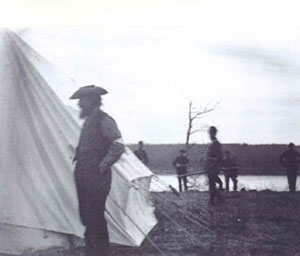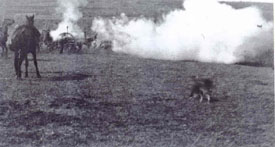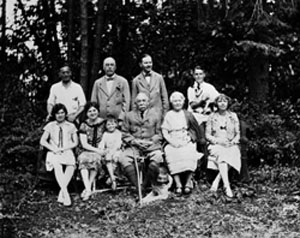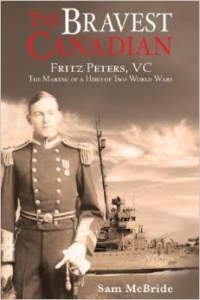The first permanent force army unit to defend Canada`s West Coast arrived in Victoria at 11 pm on November 10, 1887 on the steamer Princess Louise. Despite the late hour, a large crowd was on hand at the wharf to give a rousing welcome to ‘C’ Battery under the command of Major James Peters.

Probably Peters’s best-known photograph, titled “Riel a Prisoner”. It shows the Metis leader Louis Riel on a break outside the tent where he was kept prisoner after the rebellion forces were defeated. NAC C-3463.
As the men marched down the gangplank they were first greeted by members of the local militia, who offered Three Cheers while a military band played “The Campbells are Coming“. Mayor James Fell heartily welcomed them, saying he hoped the new arrivals would stay long in the city, because in his experience the longer people remain in Victoria the prouder they become of the city. The Daily Colonist reported the soldiers were “nearly all young men, of splendid physique, and their movements were gone through in perfect time“.
The dignitaries accompanied the soldiers as they marched to their temporary quarters at the Agricultural Hall in Beacon Hill Park where a substantial sit-down dinner awaited them. After toasts and compliments were offered back and forth, Major Peters expressed appreciation for a wonderful welcome, saying he had heard before heading west that British Columbians did not want to have anything to do with Eastern Canadians, but now he knew different. He noted that another shipload would arrive the next day with more men, along with 15 wives and 38 children. With a total of 100 gunners protecting Victoria Harbour and the nearby Royal Navy naval base at Esquimalt, this standing army fulfilled one of the promises of Confederation for B.C.
Soon after arriving, all ranks helped clear land, saw logs and build facilities for their new barracks on a tract of land in Esquimalt provided by the Hon. John Work, chief factor of the Hudson’s Bay Company. The Work Point Barracks, completed in 1890, would accommodate artillery and other military forces for more than a century.
In 1893 ‘C’ Battery returned to Quebec City and was relieved by the Royal Marine Artillery. Peters was promoted to Lieutenant-Colonel and remained as District Officer Commanding in B.C. In 1899 he was transferred to Toronto to replace an officer sent to the Boer War. After service in Montreal and London, Ontario, Peters transferred back to Victoria in 1909 and retired there a year later.

This photo of cannons and smoke is one of Peters’s photos from the Riel Rebellion, and he provided a caption -“Shelling Batoche. Last shot before the attack on the guns”. NAC C-3463.
Peters had several claims to fame in Canadian history. He was born September 11, 1853 in Saint John, New Brunswick, into a family descended from United Empire Loyalists from New York. He began his military career as a bugler with the 62nd Saint John Fusiliers when active militia were called out in 1870 to defend against a Fenian Raid. He was gazetted as a lieutenant in 1872 and given command of a detachment that was the first artillery to go to Fort Garry.
As a captain in the Northwest Rebellion in the spring of 1885, he was mentioned in dispatches for gallantry in command of ‘A’ Battery, Canadian Artillery, in actions at Fish Creek, Duck Lake, Batoche and operations against Chief Big Bear.
During that campaign he also provided regular reports as correspondent for the Quebec Morning Chronicle under the pseudonym Foggy.
As a capable amateur photographer, he had the special distinction of taking the world’s first war action photographs.

James Peters is seated at the centre of this photograph, surrounded by his family. Image H-00482 courtesy of Royal BC Museum, BC Archives.
Photographs had been taken during the U.S. Civil War and the Crimean War but, due to cumbersome equipment and long exposure times, the only images captured were taken after the battles were over.
Peters took many of his photographs from horseback with a handheld Marion Academy twin-lens reflex camera that used technology developed in the early 1880s. A selection of his photographs from the Rebellion was packaged in albums and offered for sale.
In September 1885 the Quebec Morning Chronicle paid tribute to their correspondent:
“While bullets hissed and spluttered around and overhead, and while men were falling wounded or struck dead, this photographic hero, with extraordinary nerve, cooly focussed, capped, inserted the dark slide, drew out the shutter, uncapped, capped, pushed in the shutter, and put up the camera.
“When one thus enumerates the many and delicate operations required in the taking of a photograph, Captain Peters’ exploit appears a little short of the marvellous.”
Peters was active in sports and outdoor pursuits, including big game hunting, horsemanship, rowing, fishing and golf. In the 1870s two of his horses won the Queen’s Plate in thoroughbred racing. Popular in the community, he was acclaimed as the first town councillor when Esquimalt became a municipality in 1912.
After Col. Peters’ death in May 1927 he was buried with a prominent memorial stone in the Veterans Cemetery, Esquimalt, surrounded by fairways of the Gorge Vale Golf Course.

 CFB Esquimalt Naval and Military Museum
CFB Esquimalt Naval and Military Museum CFB Esquimalt Naval and Military Museum
CFB Esquimalt Naval and Military Museum CFB Esquimalt Naval and Military Museum
CFB Esquimalt Naval and Military Museum CFB Esquimalt Naval and Military Museum
CFB Esquimalt Naval and Military Museum CFB Esquimalt Naval and Military Museum
CFB Esquimalt Naval and Military Museum CFB Esquimalt Naval and Military Museum
CFB Esquimalt Naval and Military Museum CFB Esquimalt Naval and Military Museum
CFB Esquimalt Naval and Military Museum CFB Esquimalt Naval and Military Museum
CFB Esquimalt Naval and Military Museum CFB Esquimalt Naval and Military Museum
CFB Esquimalt Naval and Military Museum CFB Esquimalt Naval and Military Museum
CFB Esquimalt Naval and Military Museum CFB Esquimalt Naval and Military Museum
CFB Esquimalt Naval and Military Museum CFB Esquimalt Naval and Military Museum
CFB Esquimalt Naval and Military Museum CFB Esquimalt Naval and Military Museum
CFB Esquimalt Naval and Military Museum CFB Esquimalt Naval and Military Museum
CFB Esquimalt Naval and Military Museum